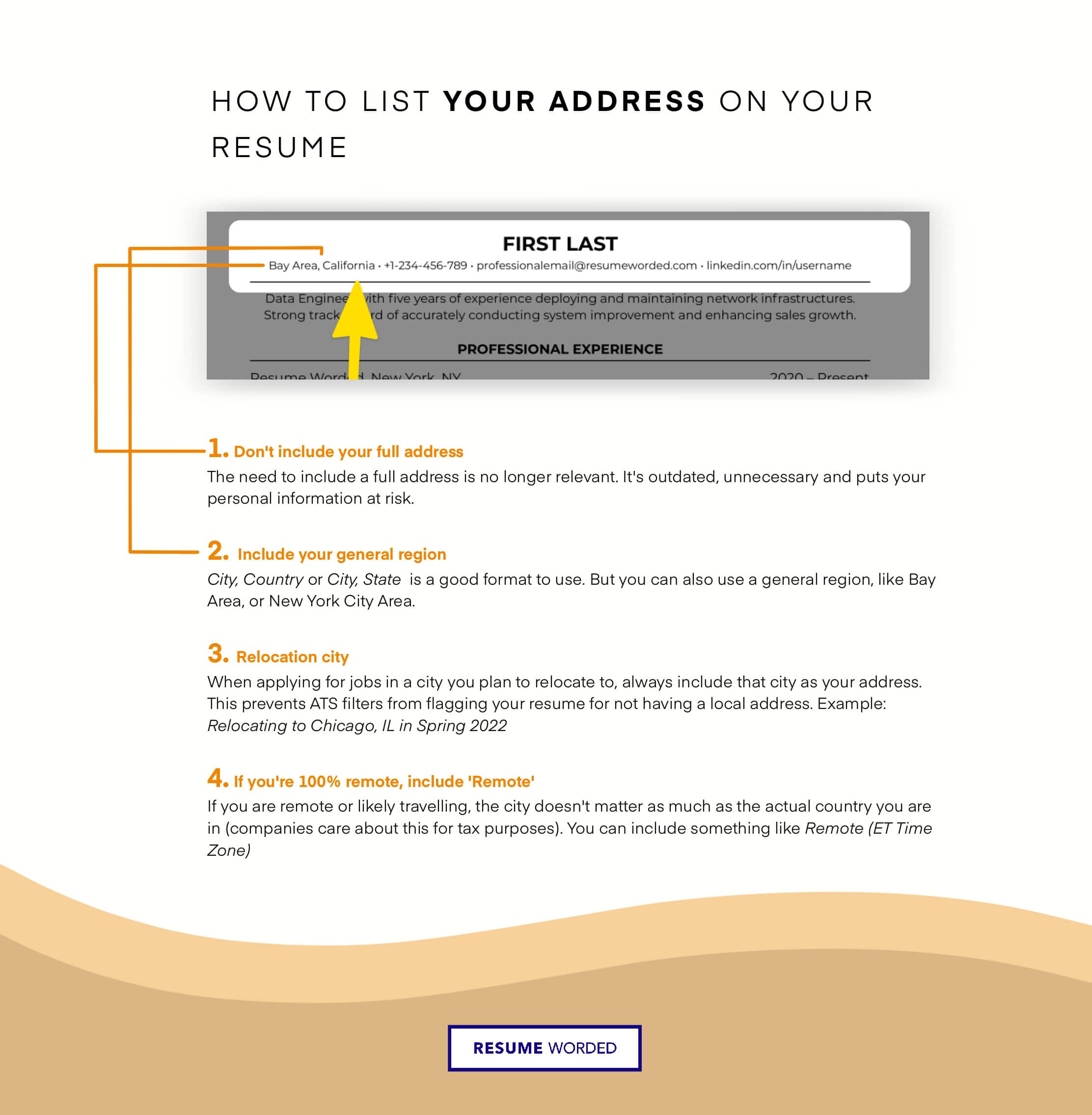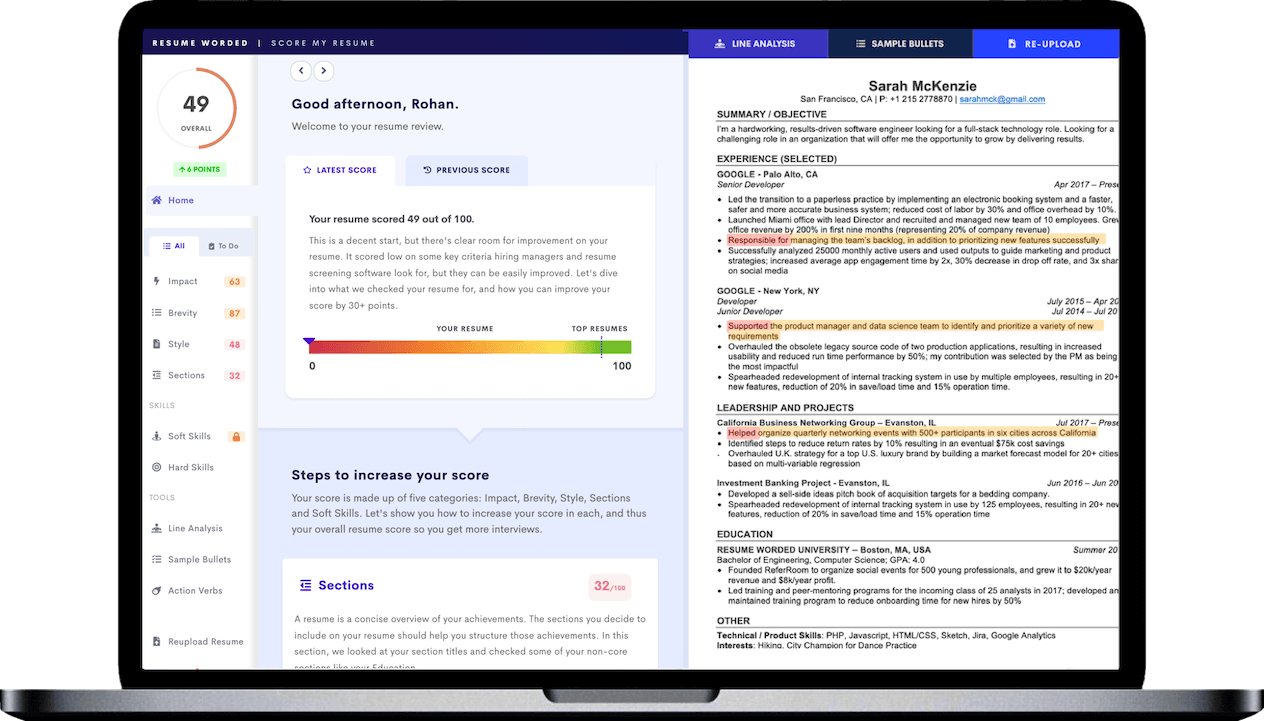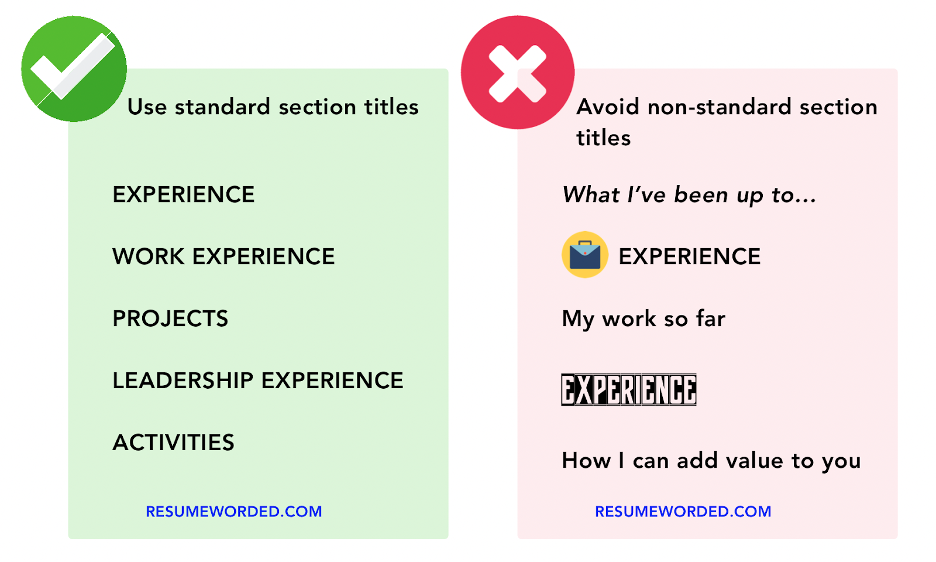In an era where remote work is becoming more and more prevalent, it can be tough to decide if your address belongs on your resume. This practice may have been commonplace 10 years ago, but is it still what recruiters are looking for in 2024?
Today, including your address on your resume depends on multiple factors, including industry trends, privacy concerns, and the nature of the role you're applying for. Including your home address can show employers you're local and available for in-person interviews. However, providing just a city and state is becoming the standard and is preferred for remote and out-of-country applications.
In this article, we’ll discuss when, why, and how you might choose to include your address on your resume, along with a few common alternatives you might prefer. We’ll discuss how this practice varies across different industries, how address requirements change for remote and international applicants, and how to make the best choice for your unique situation.
Should you put your home address on your resume?
In short, no. These days, you do not need to include your full home address on your resume. It is not necessary for most applications, especially remote work.
The benefit of including a home address is that it makes it easier for employers to verify your location and shows the recruiter you don’t need to relocate for the position. However, including your address also takes up valuable space on your resume, could lead to bias based on your geographical location, and could compromise your privacy if shared online.
Unless the application specifically requests it, you are better off just stating your city and state/country. This provides your employer with general location information to help with recruitment but does not compromise your safety and security.
How to decide if including your address is right for you
Including your home address, or a version of it, on your resume is entirely dependent on the type of application you’re submitting and the requirements of that role. Generally, it is not necessary, but there are a few situations where it might be relevant.
Why employers might want to see your home address
Some employers may need your home address for specific recruitment tasks, such as:
- Background checks
- To determine your ability to work in the country
- Criminal record checks (if required for your industry)
- For their Application Tracking System
When is it mandatory to provide an address?
Certain applications require a street address, including:
- Applying for government or public service work
- When relocation costs are relevant
- If the work is location specific, such as if knowledge of an area or in-person meetings are required
When is it ok to leave your address off your resume?
- If applying on a third-party website, it’s good practice to omit your home address for privacy and security reasons
- When applying out-of-country
- When you are moving soon, to ensure your contact details aren’t out-of-date
If you’re wondering what else, like your home address, should or shouldn’t be included on your resume, upload it to the tool below — it’ll scan your resume and give you detailed feedback on what to remove or add into your resume.
Where to include your home address on your resume
Your address should appear in your resume header, with your other primary contact information, such as name, phone number, and email address.
For example, here is a resume that includes the applicant’s address in the header using the city, state format.
Formatting options for your address
Here are some of the most common formatting options for resume addresses:
City, State
This is the most common format and widely used across various industries.Here is an example of a header using the city, state format:
City, State, Zip Code
This is a good alternative to the above if you are applying locally.See how this applicant uses the city, state, zip code format in their resume header:
City, Country
This style is useful for out-of-country and remote job applications.This applicant uses the city, country format in their two column resume:
Area or Region
This format is great for local applications.For example, this applicant uses both their general area address and a LinkedIn profile in their header:
Any of the above, plus “Open To Remote”
This is a good way to indicate location flexibility.This resume uses the city, state format and Open to Remote for their address:
How to write your home address depending on your type of residence
How to list your home address will vary depending on your living situation. Here are some options to consider:
Residential vs permanent address
If you have two addresses, opt for the address where you reside most often. If you’re applying for a location-specific job, choose the location that best fulfills the job requirements, or that is closest to your employer.
If you are currently living at a temporary address, you can list both permanent and temporary addresses, indicating which is which, or opt for just your permanent address.
For example:
Permanent Address: 123 Main Street, Hometown, State, Zip Code
Temporary Address: 456 College Ave, Campus Town, State, Zip Code
In this example, the permanent address is listed first, followed by the temporary address, with clear labels for each.
If you are relocating
If you are in the process of relocating, it is acceptable to write that you are “relocating to X”. Include a date for your relocation or simply put the city or area you will be moving to shortly.For example:
Relocating to San Francisco, CA | P: +1 215 2778870 | [email protected]
Relocating to San Francisco by 05/23 | P: +1 215 2778870 | [email protected]
Including a PO Box
If your home address includes a PO Box, it is not necessary to include this on your resume. If your employer requires a postal address, they will ask for it specifically. You can also consider using a PO Box as an alternative to a street address.
If you live in an apartment complex
If you live in an apartment building, it is not necessary to include your apartment number, complex name, or street address. Opt for just City and State, or region. Only use a complex name if applying locally.
Alternatives to putting your home address on your resume
Let's dive into some practical alternatives to putting your full home address on your resume.
Use a general location: City and State
General locations are the best alternative to using your full street address. They take up less space while still providing the appropriate information. This is fast becoming the most popular option in most industries.
Use a general area or district
If applying locally, when distance or specific location is relevant, consider using a general area or district name. Be sure it is a name your employer will recognize and isn’t too specific or long-winded.
A good example: Creekside, Whistler, BC
A bad example: Gondola Way, Creekside, Whistler Blackcomb Mountain Resort, Whistler, BC.
Use your email address
This is common practice when applying for out-of-country or remote work, as email will likely be your primary avenue of communication. Ensure your email communications are professional and send the right message by researching email networking templates before you apply.
Use a virtual address
If you have a website or an online portfolio, you can use these as a virtual address. This is best for remote-job applications.
Use your LinkedIn profile as your address
LinkedIn is quickly emerging as the go-to tool for recruiters and a great place to find your next job. Many recruiters expect a LinkedIn profile these days and providing one in place of your physical address is common in creative and freelance industries.
If you plan to use your LinkedIn profile as your address, give our LinkedIn Review tool a try to ensure your profile is optimized for the work you’re seeking and receive tailored feedback on improving your visibility.
Advice for local, remote, and overseas applications
Whether you're applying just around the corner or across the globe, let's explore some tailored advice for local, remote, and overseas job applications to help you get your address just right.
Applying locally vs further afield
You can use small town or district names if applying locally, but stick to large cities if applying from afar. For example: If you live in Vancouver and are applying for a job in Vancouver, you can use “North Vancouver” or “Burnaby”, but for jobs elsewhere, stick to simply “Vancouver”.
North America vs Europe
When applying for work in North America, it is common to only state City and State for your address. Whereas in Europe, it is still best practice to include your full address and zip code.
Applying overseas
When applying overseas, it is customary to include your nearest city (preferably a large city the recruiter will have heard of) and your country of residence, so recruiters are aware of your current time zone.
Applying for remote work
When Applying for remote work, City and State, or City and Country is most common. You can also include the phrase “Open To Remote” next to your address, to indicate this. You may also choose to omit your address entirely for remote applications to avoid any potential geographical bias.
Industry-specific considerations for including your address on your resume
Different industries have different expectations when it comes to the relevance of your address. Assessing the job description, company culture, and industry practices can help you decide on including your address or not.Here are some key industry-specific considerations:
- Government and public service: In fields like government or public service, including your full address is often necessary due to security clearances, residency requirements, and background checks.
- Tech and startups: In tech and startup environments, where remote work is prevalent, the focus is usually more on your skills and experience than your geographical location. Here, city and state are commonly preferred unless the job is location-dependent.
- Healthcare and education: In healthcare and education, especially for roles tied to specific institutions, including a local address can be helpful, or at least indicating that you are willing to relocate.
- Creative and freelance work: In creative industries, physical location is often less relevant as remote work is more prevalent, and your portfolio, skills, and adaptability hold more weight than geographical location.
- Sales and retail: For sales and retail, especially when the job requires knowledge of a specific area, including your address can demonstrate your familiarity with the area.
- Manufacturing and logistics: In these industries, location can be important for roles requiring physical presence in a specific area, so including a full address can be beneficial.
- Remote-first companies: For companies with a remote-first policy, your specific address is often irrelevant. Highlighting your ability to work remotely is more crucial.
- International companies: If you're applying to international companies, especially where relocation might be involved, city and country are preferred, as well as mentioning your willingness to relocate if necessary.
Advice for international job seekers
International job seekers face unique challenges when it comes to including an address on their resume, as the format and relevance of your address can vary significantly depending on the country you are applying to.
Understand the norms of the country
Research the standard resume practices in the country you're applying to. In some countries, a full address, including street and zip code, is standard, while in others, the city and country are more common. When providing a full address, follow international postal standards. This makes it easier for employers from other countries to understand and process your information.
Use city and country format
For international applications, it's advisable to include your city and country, especially if you're applying from a different country than the job location. This provides clarity on your current location without the need for full address details.
Consider the employer's perspective
Think about what the employer needs to know. If the job isn't location-dependent, such as in remote work, the specific address is less relevant.
Indicate your willingness to relocate
If you’re applying for a job in a different country and are willing to relocate, make this clear. You can do this by including a line such as 'Willing to relocate' near your address in your resume header.
Resume address FAQs
Do employers verify home addresses on resumes?
It's important to be aware that providing an address on your resume can lead to its verification. Employers may verify your home address for various reasons, including background checks, assessing commute times, or confirming local residency. This verification is usually part of a broader background check process and may involve simple methods such as checking public records or more thorough inquiries through background check services. If you're concerned about privacy or safety, consider including only your city and state.
What address should I use if I live in shared housing or have privacy concerns?
If you live in shared housing or have privacy concerns, it's important to balance your safety with the need to provide location information. Remember, you can include just your city and state instead of a full street address. This approach respects your privacy and the confidentiality of those you live with while still giving potential employers an idea of your geographical location.
Can I use a fake home address?
This is not recommended. Any form of lying on your resume is a poor first impression, and providing a false address will only impugn your character if you’re found to be lying.
Does including your home address affect ATS?
Many employers use Applicant Tracking Systems (ATS) to filter resumes based on keyword criteria. For roles that require local candidates, ATS might be configured to prioritize resumes with local addresses. Conversely, for remote positions, ATS might be looking for the terms “remote” and “open to remote” instead.
Excluding your home address won't necessarily disadvantage your application, but if you are applying for a local position, including a local area/city might be beneficial. However, many modern ATS algorithms focus more on your skills, experience, and qualifications rather than your location, especially if the job is not location-specific.










